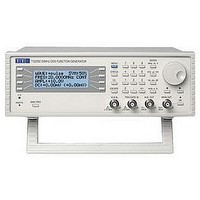TG2000 AIM-TTI INSTRUMENTS, TG2000 Datasheet - Page 3

TG2000
Manufacturer Part Number
TG2000
Description
FUNCTION GENERATOR FREQUENCY/PULSE 20MHZ
Manufacturer
AIM-TTI INSTRUMENTS
Datasheet
1.TG2000.pdf
(4 pages)
Specifications of TG2000
Signal Generator Type
Pulse
Bandwidth
20MHz
Modulation Type
Gated/Sweep/AM/FSK/Tone/Internal Trigger/Gate Generator
External Height
88mm
External Width
260mm
External Depth
235mm
Ease of use
The TG1000 and TG2000 are particularly
easy to use. All of the main information is
clearly displayed on a backlit LCD with 4
rows of 20 characters. Sub menus are
used for the modulation modes and other
complex functions.
All parameters can be entered directly from
the numeric keypad. Alternatively most pa-
rameters can be incremented or decre-
mented using the rotary encoder for
quasi-analogue control.
Frequency or period entry
The generator frequency can be set in
terms of either frequency or period.
Numeric entry is floating point using what-
ever units the operator prefers.
Flexible amplitude entry
Amplitudes can be entered in terms of peak
to peak voltage, RMS voltage or dBm.
The output impedance can be set to 50W or
600W, and the amplitude can be set in
terms of either the voltage into the correct
termination, or the source EMF (for a high
impedance load).
Quick recall of settings
Both generators provide nine memories for
storing settings.
Because all parameters are controlled
electronically, the memories store the full
set-up of the instrument and automated
test sequences are easy to set up.
In addition to the nine user memories, the
current state of the instrument is saved at
switch off. The user can choose to have
this state restored at switch on, or choose a
pre-defined default set-up.
Synchronisation
The auxiliary output socket can provide any
one of three different Sync. signals.
Waveform Sync is a 50% duty cycle square
wave at the frequency of the main output.
Sweep Sync. outputs a pulse at the start of
each sweep and can also output a pulse at a
user defined marker frequency.
Trigger Out provides a replica of the trigger
signal which can be from the trigger input
socket, the internal trigger/gate generator,
the manual trigger key, or the bus interface.
and full digital control via RS-232 or USB (TG2000 only)
See the difference !
Ultimately what matters in a function gener-
ator is the quality of the output signal.
The TG1000/2000 maintains the TTi
reputation for high signal quality at all
frequencies and all levels.
The waveform capture opposite shows just
how much difference that can make !
The 'scope display opposite was captured
from two 5MHz square wave signals each at
60mV pk-pk level into 50 W .
The upper waveform is from a widely avail-
able competitive DDS generator.
The lower waveform is from a TG2000.
Modulation modes
Sweep
All waveforms can be swept over their full
frequency range (0.2Hz minimum) at a rate
variable between 50 milliseconds and
more than 15 minutes. The sweep is fully
phase continuous.
Sweep can be linear or logarithmic, single
or continuous. Single sweeps can be trig-
gered from the front panel, the trigger input,
or the digital interfaces.
A sweep marker is provided that is adjust-
able whilst sweep is running. The markers
can provide a visual indication of frequency
points on a ‘scope or chart recorder.
Gated
The Gated mode sets the output signal on
or off depending on the gating signal state.
The gating source can be the front panel
key, internal trigger generator, trigger input
socket, or bus interface signal.
AM
External Amplitude Modulation of up to
100% is available for all waveforms via the
VCA input.
FSK
Frequency Shift Keying provides phase co-
herent switching between two selected fre-
quencies at a rate defined by the source.
The switching source can be the front panel
key, internal trigger generator, trigger input
socket, or bus interface signal.
Tone Switching
The generator can be set to switch be-
tween a number of different frequencies in
response to a trigger signal.
Up to 16 frequencies can be defined.
Phase continuous frequency sweep.
Amplitude modulation using an external sine
wave modulation source.
Frequency switching in FSK mode.



